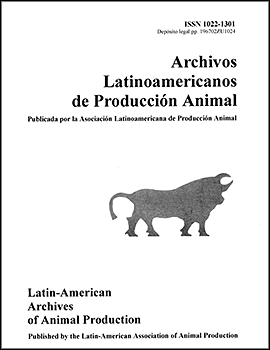
|
Archivos Latinoamericanos de Produccion Animal
Asociacion Latinoamericana de Produccion Animal
ISSN: 1022-1301
EISSN: 1022-1301
Vol. 12, No. 4s1, 2004, pp. 16-21
|
 Bioline Code: la04020
Bioline Code: la04020
Full paper language: Spanish
Document type: Research Article
Document available free of charge
|
|
|
Archivos Latinoamericanos de Produccion Animal, Vol. 12, No. 4s1, 2004, pp. 16-21
| es |
Características morfológicas del caprino Criollo venezolano
F. A. Pariacote, L. Ruiz, D. C. D'Ascencao, C. Borges y X. Pimentel
Resumen
Como una contribución a la caracterización del caprino Criollo en Venezuela, un total de 506 mediciones de ancho del pecho, altura del pecho, alzada del pecho, alzada a la cruz, perímetro toràcico, largo escàpulo-isquial, largo del cuerpo, anchura anterior de la grupa, anchura posterior de la grupa, largo de la grupa, y peso corporal, en hembras mayores de 15 meses de edad, seleccionadas en forma aleatoria de rebaños comerciales (n = 8) representativos de sistemas típicos de producción, con àreas de pastoreo común localizadas en ambientes àridos, fue analizado. La fracción directa de genes de Alpino, Canaria, Criollo, y Nubian fueron de 2±0,3; 0,0±0,1; 95±0,5; y 3±0,4 %, respectivamente. No hubo individuos puros, excepto criollos. La heterocigosis promedio fue de 0,07±0,01, con un màximo de 0,63. La media y desviación estàndar, sin ajustar, de las variables mencionadas fueron de 15,7±2,7; 31,0±3,9; 36,4±3,6; 66,3±5,2; 75,2±7,7; 67,7±7,0; 94,2±8,6; 14,1±2,1; 10,0±2,0; 19,8±1,8; y 29,7±8,0; respectivamente. El anàlisis univariado, con rebaño y las co-variables edad, lineal y cuadràtica, y fracción directa de grupo racial como efectos fijos, detectó diferencias estadísticamente significativas entre rebaños, con amplitudes de hasta 50 %, y también entre los coeficientes de regresión sobre la fracción directa de genes. Los estimados del Criollo representan de 60 a 72 % del mejor entre el resto de los grupos evaluados. Las mediciones correspondientes a las regiones toràcica, de la grupa, y largo del cuerpo lucen igualmente correlacionadas dentro y entre regiones, con valores de entre 0.18 y 0.63. En todas las regiones hubo variables altamente correlacionadas con peso corporal. Los vectores de auto-valores y valores propios, estimados a partir de la matriz de co-variancia, indican que cinco de los componentes principales explican el 81 % de la variación. Los resultados son indicativos de que la dimensiones del eje axial del caprino Criollo venezolano son inferiores pero con mayor variación que la de los caprinos exóticos.
Palabras-clave
Caprino, Criollo venezolano, Características morfológicas
|
| |
| en |
Morphological traits of venezuelan Creole goat
F. A. Pariacote, L. Ruiz, D. C. D'Ascencao, C. Borges y X. Pimentel
Abstract
As a contribution to the characterization of Creole breed of goats in Venezuela, a total of 506 measurements of chest width, chest tallness, chest height, withers height, thorax perimeter, scapula-thurl long, body long, hip width, posterior rump width, rump long, and body weight from females older than 15 months of age, randomly selected from commercial flocks (n = 8) representative of typical production systems, with common shepherding, and located in arid environments. Direct fraction of gens from Alpine, Canaria, Creole, and Nubian breeds were of 2±0,3; 0,0±0,1; 95±0,5; and 3±0,4 %, respectively. There were not pure breed individuals, except Creoles. The heterozygosis averaged 0,07±0,01, with a maximum of 0,63. The raw mean and standard deviation for traits mentioned were of 15,7±2,7; 31,0±3,9; 36,4±3,6; 66,3±5,2; 75,2±7,7; 67,7±7,0; 94,2±8,6; 14,1±2,1; 10,0±2,0; 19,8±1,8; and 29,7±8,0; respectively. The single trait analysis, with flock and the co-variables age, lineal and quadratic, and direct fraction of breed as fixed effects, detected differences statistically significant among flocks, with ranges of up to 50%, and also among the regression coefficients on the direct fraction of breed genes. The Creole breed represents from 60 to 72 % of the best among the rest of the evaluated breeds. Traits of the thoracic, rump, and body regions seem equally correlated with within and among regions, with values from 0,18 to 0,63. In all regions there were variables highly correlated with body weight. Eigenvalues and eigenvectors are indicative that five of the main components explain 81 % of the variation. Results are indicative that axial dimensions of the Venezuelan Creole goat are shorter but with higher variation than those of exotic breeds.
Keywords
Goat, Venezuelan creole, Morphological traits, Extensive systems
|
| |
© Copyright 2004 - ALPA. Arch. Latinoam. Prod. Anim.
Alternative site location: http://www.alpa.org.ve/ojs/index.php
|
|
